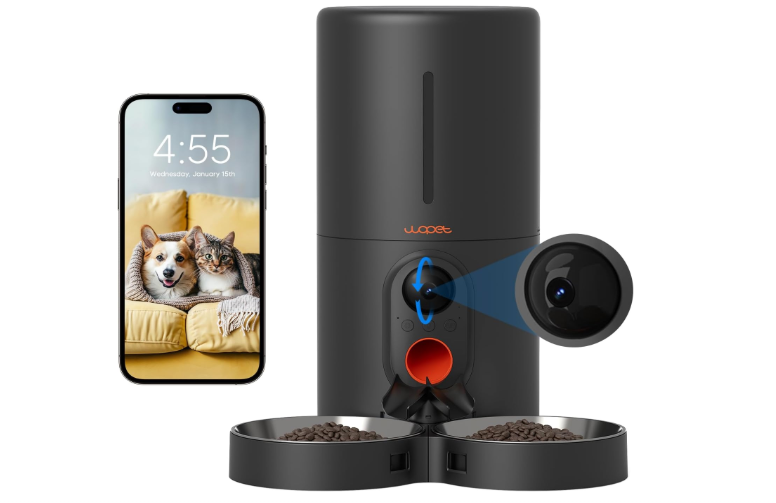Are you tired of waking up at 5 AM to feed your hungry feline? Do you worry about your cat's meal schedule when you're stuck late at work? A programmable Wi-Fi cat feeder might be the solution you need. This guide walks you through the entire process of setting up and programming a smart cat feeder so you can manage your pet's meals from anywhere.
Why Choose a Wi-Fi Connected Cat Feeder?
Smart cat feeders let you control feeding schedules remotely, monitor your cat's eating habits, and ensure your pet never misses a meal. Unlike traditional automatic feeders, Wi-Fi models give you flexibility to make real-time adjustments through a smartphone app.
Benefits of smart feeders include:
- Feed your cat from anywhere with internet access
- Receive alerts when food is dispensed
- Track your cat's eating patterns
- Make immediate schedule changes without being home
- Some models even include cameras to check on your pet
What You'll Need
Before diving into programming, gather these essentials:
- Wi-Fi enabled automatic cat feeder
- Smartphone (iOS or Android)
- Home Wi-Fi network with stable connection
- Cat food appropriate for your feeder model
- Basic understanding of electronics (helpful but not required)
- Optional: Raspberry Pi or Arduino (for DIY projects)
Choosing the Right Wi-Fi Cat Feeder
Several factors should guide your selection:
Food Capacity and Type
Consider how long you're typically away and your cat's dietary needs. Most feeders handle dry food, but some specialized models can dispense wet food too. Larger capacity feeders need less frequent refilling but might keep food less fresh over time.
Power Source
Battery-powered feeders work during power outages but require regular battery changes. Models with power adapters and battery backups offer the best reliability.
App Functionality
Check which features each feeder's app offers:
- Custom feeding schedules
- Portion control options
- Feeding history logs
- Low food alerts
- Battery status updates
Additional Features
Premium models might include:
- Built-in cameras
- Two-way audio
- Multiple pet settings
- Slow feed options to prevent gulping
- Food level sensors
Setting Up Your Wi-Fi Cat Feeder
Once you've selected your feeder, follow these steps to get it running:
Physical Setup
- Unpack your feeder and read the manufacturer's instructions
- Insert batteries or connect power adapter
- Clean all food compartments thoroughly
- Place the feeder on a flat, stable surface
- Fill the food reservoir with appropriate dry food
Network Connection
- Download the manufacturer's app on your smartphone
- Create an account if required
- Turn on the feeder and put it in pairing mode (usually by holding a specific button)
- Connect your phone to your home Wi-Fi network (2.4GHz networks work best for most IoT devices)
- Follow app instructions to pair the feeder with your network
- Test the connection by triggering a small food release
If you encounter connection problems:
- Move the feeder closer to your Wi-Fi router
- Check if your network has too many connected devices
- Ensure your router isn't blocking new devices
Programming Feeding Schedules
Now for the fun part! Let's set up custom feeding schedules:
Basic Schedule Setup
Most apps let you set multiple feeding times with different portion sizes:
- Open your feeder app
- Navigate to schedule settings
- Add feeding times based on your cat's needs
- Set appropriate portion sizes for each feeding
- Save your settings
- Run a test feeding to confirm everything works
Advanced Programming Options
Depending on your feeder model, you might have access to:
Gradual Feeding
Program small portions to dispense over time rather than all at once. This helps cats who eat too quickly or have digestive issues.
Meal Alerts
Set up notifications so you know when your cat has been fed. Some systems can even alert you if your cat hasn't approached the feeder after food dispensing.
Manual Override
Learn how to trigger immediate feedings through the app when needed.
Multiple Pet Profiles
If you have several cats with different dietary needs, some feeders allow for individualized feeding patterns.
DIY Wi-Fi Cat Feeder Projects
For tech-savvy pet owners, building your own smart feeder can be rewarding:
Raspberry Pi Feeder
With a Raspberry Pi, servo motor, food container, and some coding skills, you can create a custom feeder:
- Set up Raspberry Pi with Raspbian OS
- Connect servo motor to GPIO pins
- Build a simple food container with dispenser
- Write or download feeding schedule code
- Create a web interface for remote control
- Test thoroughly before leaving your cat dependent on it
Arduino-Based Feeder
Arduino offers another excellent platform for DIY feeders:
- Use Arduino Uno or ESP8266 for Wi-Fi capability
- Connect stepper motor for food dispensing
- Add a real-time clock module for accurate feeding times
- Program feeding schedules using Arduino IDE
- Create a simple app interface with Blynk or similar platforms
Troubleshooting Common Issues
Even the best feeders sometimes have problems. Here's how to fix them:
Connectivity Issues
If your feeder disconnects from Wi-Fi:
- Check your home internet connection
- Restart your router
- Move the feeder closer to the router
- Update the feeder's firmware if available
Food Jams
When food gets stuck:
- Use only recommended food types and sizes
- Clean the dispenser mechanism regularly
- Avoid filling the hopper completely full
- Check for moisture that might cause clumping
Battery Problems
To prevent power failures:
- Replace batteries according to the manufacturer's schedule
- Clean battery contacts if corrosion appears
- Consider a UPS (uninterruptible power supply) for plug-in models
Maintaining Your Wi-Fi Cat Feeder
Regular maintenance keeps your feeder working reliably:
Cleaning Schedule
- Clean food containers weekly
- Wipe down dispensing mechanisms monthly
- Check for food dust buildup in moving parts
- Sanitize food bowls regularly
Software Updates
- Keep the feeder app updated to the latest version
- Install firmware updates when available
- Back up your feeding schedules before major updates
Security Considerations
Smart devices need protection too:
- Use strong passwords for your feeder app account
- Keep your home Wi-Fi network secure
- Update firmware regularly to patch security vulnerabilities
- Be cautious about connecting your feeder to public networks
Training Your Cat to Use the Automatic Feeder
Cats can be skeptical of new devices. Help them adjust with these tips:
- Place the feeder next to their current feeding spot
- Initially, feed them manually from the feeder's bowl
- Run the feeder while your cat watches to familiarize them with the sounds
- Offer treats or praise when they approach the feeder
- Gradually transition to automatic feeding over 1-2 weeks
Integrating With Smart Home Systems
Take your setup to the next level:
Voice Assistant Integration
Many modern feeders work with systems like:
- Amazon Alexa
- Google Home
- Apple HomeKit
Set up voice commands such as "Alexa, feed the cat one portion" for convenient manual feeding.
IFTTT and Other Automation
Create custom triggers:
- Feed your cat when you turn off your morning alarm
- Receive a text message when feeding happens
- Log feeding times to a spreadsheet automatically
Real-Life Success Stories
Pet owners report positive changes after switching to smart feeders:
Sarah from Portland says: "My cat used to wake me at 4 AM daily. Now the feeder gives him a small morning portion, and I get to sleep until 7!"
James in Chicago notes: "When I got stuck at the airport during a storm, I could still feed my cats on schedule using the app. The peace of mind was worth every penny."
Final Thoughts
A Wi-Fi cat feeder simplifies pet care while giving you greater control and monitoring capabilities. Whether you're dealing with a cat on a diet, managing multiple pets, or simply streamlining your daily routine, these devices offer practical solutions that benefit both you and your feline friends.
Remember that technology should enhance your relationship with your pet, not replace your attention and care. Use the time saved from manual feeding to play, cuddle, and bond with your cat in other meaningful ways.
With the right setup and regular maintenance, your smart cat feeder will provide years of convenient, reliable service -- and your cat will never miss another meal, even when you're away from home.
Happy feeding!

